Security badges — identification pieces with photographs on them — are one of the more ubiquitous showings of a security state. In Washington, DC, where I live, they are an extremely common sight: a thick plastic card with a photograph and a name of an agency, strung on a garish lanyard around the neck of someone dressed extremely conservatively. Apparently among those inside this world, it is considered a standard practice to subtly glance down at the badges of other people you see around, comparing agencies, clearances, status.
When did identification badges become so common? I’m not sure. Did they have them, say, in the secret facilities employed during World War I? I’ve never seen one. I’ve seen non-identifying badges — the equivalent of a police shield — but not ones with individual names and photographs. Presumably they had a way of indicating who belonged inside the secret areas and who belonged outside, but whether that was an identification card, a sheaf of papers, or something else, I’ve no clue. The photographic identification badge, worn at all times, seems to have come out of nowhere around the time of World War II, like so many things associated with the modern American security state.
At Los Alamos during the Manhattan Project — Project Y, as it was called — badges served multiple purposes. They said who was allowed inside the facility, sure. No badge, no entry. But they were also color-coded to describe the breadth of your access. Yellow meant that you could go into technical areas of the lab, but could receive no classified information — like guards. Blue was for people who needed classified information but not technical information — clerks and warehouse employees. Red was for people who could get some technical information within a highly compartmentalized state — technicians and secretaries. White was for those who could know it all — everything that was to be done at Los Alamos. Early on, General Groves had wanted Los Alamos to be considerably compartmentalized, but Oppenheimer and others fought it. The result was that white badgers had the run of the lab, more or less, and could attend laboratory-wide colloquia.
The old Los Alamos badges of yore are declassified and have been digitized. They make for an interesting visual portrait of Los Alamos — one that likely nobody expected would ever be compiled and shared widely. They were internal documents for internal purposes, now opened up to history. It’s tempting to read the character traits we expect into the expressions on the badges. Look at J. Robert Oppenheimer‘s badge, above. He looks small and vulnerable — brilliant but wary, burdened by heavy responsibilities.
By contrast, here is the young Richard Feynman, who looks serenely amused at the entire thing, completely unimpressed, a little bit wicked:
And then we have Klaus Fuchs, that cold fish. The spy who nobody suspected, a man whose mildness — even blankness — in appearance concealed a not-inconsiderable-amount of ideological belief and daring. The guy got beat up fighting Brownshirts in the streets of Germany, but you’d never guess it from his Los Alamos persona:
And the other major physicist-spy, Ted Hall, looks just as bored, irritated, and condescending as we’d expect from the boy-wonder Harvard undergraduate who decided that he alone could determine the fate of world affairs:
In case you’re wondering whether poor Ted “Theordore” Hall was the only one with a really obvious misspelling on his badge photo, look no further:
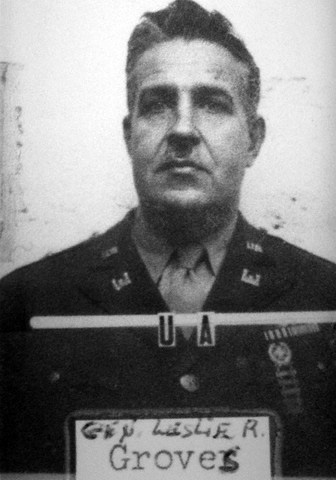
General Leslie R. Groves, overall head of the Manhattan Project, originally had “Grover” written on his identification tag. Which was apparently unnoticed until after the tag was glued on to the photograph, at which point it had to be corrected by hand. That’s kind of sad. What’s being the head of the Manhattan Project get you, if not some respect?
Sometime back, Los Alamos digitized a huge number of these staff photographs, though they are available only in practically microscopic dimensions online. There are some 1,229 badge photographs on the page — some of famous people, some of infamous people, and some of people that nobody has probably heard of since. It’s a fun feature, though like most people who look at it, I’ve spent most my time hunting for the famous names (Fermi, Teller, Bethe) and ignore most of the others.
But it’s exactly the others that make Los Alamos so interesting. It wasn’t just a small cabal of world-famous physicists — it was a massive collection of physicists, mathematicians, chemists, metallurgists, physicians, engineers, technicians, secretaries, librarians, housekeepers, cleaners, nurses, laborers, and other people who are necessary to make a lab function.
Being a tech-savvy fellow I realized it would actually be pretty easy1 to extract all of the images from the LANL website and turn them into one giant composite image, which I present for you below — click the image to open it up.
You should be able to click on the image to zoom or pan it, or use the controls at the bottom of the screen. It mostly seems to work on the iPad. (It struggles on old computers running old browsers, I’m sorry to say.) I highly recommend the full screen mode, enabled by clicking the little icon in the bottom right corner. The photo names are extracted programmatically from the filenames provided by LANL; there are some obvious typos, mistakes, and so forth that I haven’t tried to correct. If it absolutely won’t work for you, you can look at the full image here, but I warn you that it’s a big file.
They are arranged in alphabetical order. Hunt around and you’ll occasionally find a famous person, in a sea of the unfamous. Look at the sheer diversity of age, gender, and appearance. One is artfully blurred; there are at least two duplicate pairs — one is rather plain, while another shows a change in facial hair. (There is not much diversity in race, unsurprisingly. There are groups of Hispanic men in there — e.g., Lopez, Lopez, Lopez, and Lopez — but other than that, Los Alamos as represented here was a pretty “white” gathering. This is in stark contrast with Hanford and Oak Ridge, which used large numbers of African-American workers.)
I thought this was pretty enough to make a mug out of it. For the mug, I picked out 95 faces — including all of the famous and infamous ones, along with some visually interesting ones — and wrapped them around a mug. There’s no explanatory text, just faces, with an Oppenheimer and a Fuchs peaking out from among the crowd, plus a few people whose faces you probably don’t know, but would be amused to find in there (like Sam Cohen, the “inventor of the neutron bomb”).
If the anonymous crowd isn’t your thing, there is also a mug of The Big Four of the nuclear scene — Oppenheimer, Teller, Groves, and Fuchs — and, just on the off-chance someone other than me would find wearing a Klaus Fuchs t-shirt amusing, some clothing designs with these fellows on them. All proceeds go towards supporting the blog.
- I used DownloadThemAll plus ImageMagick Montage, if you are curious what goes into making this sort of thing. The image viewer was cobbled together from Microsoft’s sadly defunct Seadragon Ajax library. [↩]
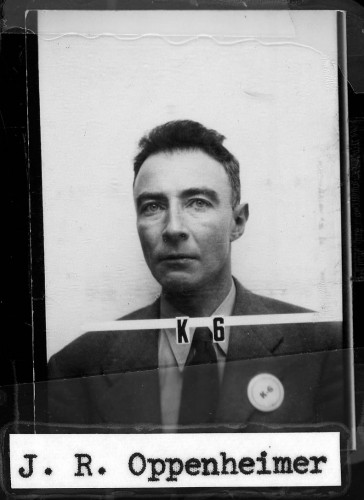
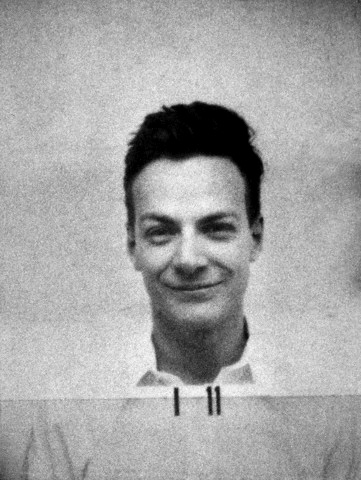
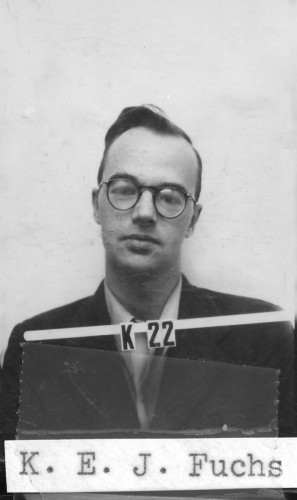
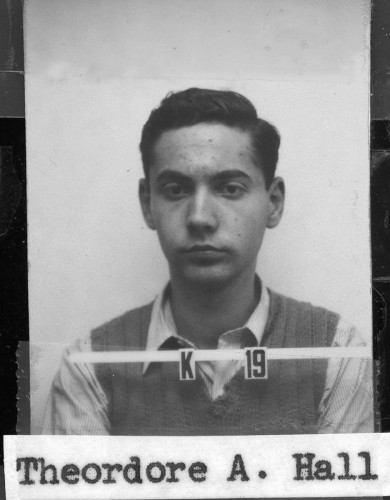
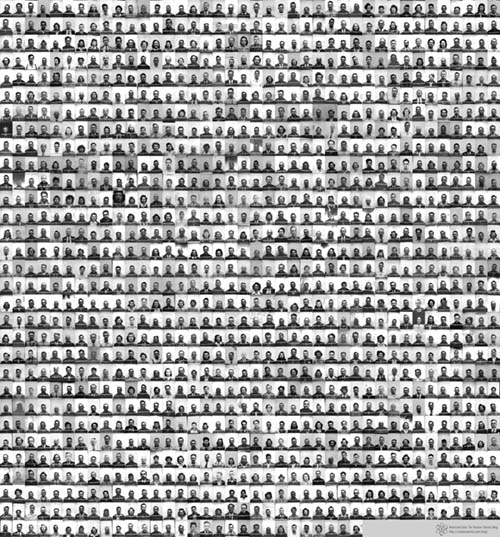
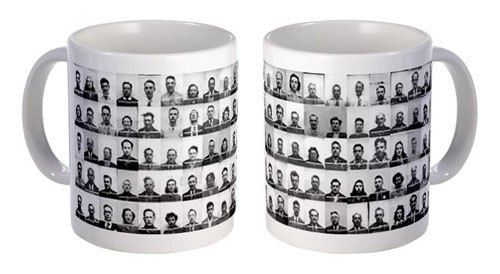



Hey Alex,
Do you know if there are badge photos for the folks working over in Chicago? My grandmother was actually a secretary on the Manhattan project. It would be cool to see her badge photo if it were out there!
Geoff
I am sure such badges existed and are probably sitting around in a box in an archive, but I’ve never seen them, unfortunately!
If anyone comes across an archive or Hanford badges, I’d be interested in those. An aunt worked there during WWII as a secretary, supposedly for someone “important.” In my mind, if you even have a secretary, you’re probably relatively important, but that was before the word processor… ;>)
Hi Alex. Awesome work!
I see Rose Bethe had a badge, but not Mrs. Fermi? Was Rose somehow unique? Where are the wives?
Hi Andy,
Many of the wives are on there, but there are conspicuous absences — both among the wives and other personnel. Three possibilities that strike me as equally plausible: 1. Los Alamos just didn’t scan them; 2. Los Alamos doesn’t have them; 3. These might only be badges for people cleared to enter the Technical Area, which might not have included some of the wives. Some of the wives on there, like Charlotte Serber, definitely had jobs in the Technical Area (Mrs. Serber ran the technical library). Laura Fermi was a clerical assistant to Louis Hemplemann’s secretary in the Tech Area when she arrived, and had a blue badge, so it’s probably one of the other two reasons for her.
Oppenheimer and Teller’s wives are there, among others. Donald Hornig — the guy who designed the triggered spark gap switch that initiated the Trinity gadget — is missing, but his wife, Lilli, is there. So there are some inconsistencies.
Photo V-150 is my grandfather, Ramon Gómez. To his right is his brother, Tobías Gómez. To Tobías’s right is Donaciano Gonzales, who lost his ranch during the acquisition process in Los Alamos. My grandfather, Tobías, and 3 other brothers were tool cleaners, laborers, and they all died of cancer. I am currently writing my dissertation on the effects of Project Y for the locals.
M., thank for sharing that. It’s amazing to be able to put some real lives behind the photos that are not as well-known.
Hate to be picky, but no Feynman shirt? Copyright problems, perhaps? But then maybe not, as the heirs to the rights held by the USSR and GDR would surely assert assert them over Fuchs’ image too.
I’m not very worried about copyright (the picture is a work of the federal government, and thus in the public domain*), but I admit to being wary of personality rights for people like Feynman. For the others, not so much. Maybe Oppenheimer, but I’ve never heard of his estate being picky about that. Einstein and Feynman though have definitely picky estates; they’re real brands, unlike the others. I’ll use their photos, but I won’t put them on products.
*Things get slightly more complicated than this, copyright-wise, since Los Alamos was run by a contractor (the University of California, in this case), but since the security angle was likely handled by the Army and not the civilian contractors, I’m assuming this is legally a “work of the federal government” until otherwise corrected.
Very cool!
X-71 …My uncle Rudy Vergoth the A-Bomb Man!
An example of a later security badge for the 1958 HARD TACK tests for Walmer E. Strope can be found on the net.
http://www.thriftywebsites.us/stropesus/images/Hard%20Tack%20Badge%201958.jpg
The Top Secret Sigma scheme on this badge appears to be still in use today.
The Sigma levels leaked out and are preserved in this document.
http://web.archive.org/web/20060908141749/http://labs.ucop.edu/internet/security/brief04/docs/sigmas.pdf
In this case, “SIGMA 4. Information inherent in preshot and postshot activities necessary in the testing of atomic weapons or devices. Specifically excluded are the theory of operation and the design of such items.”
So the classification scheme is itself secret along with the names and purposes of the compartments?.
It’s the only later badge I’ve seen. There must be someone working on typologies and evolution of security badges?
I’d be surprised if much work has been done on the history of security badges. I have a few examples of other badges through the years, but I’m saving those for another post. The labs, et al., aren’t supposed to let their images circulate, but given that the scientists in question wear them all the time while at the lab, and photographs are often taken of scientists at the labs, you can find them if you look carefully. I have a small collection of such photographs which I’ll put up another day. Thanks for the Hard Tack one, though; I hadn’t seen it.
I don’t think the SIGMA scheme itself is currently classified; you can find it here and there attributed to DOE releases.
Do we know which people had what color badge?
(Glad to see my man Cornog made it onto your mug! Though his ID photo is terrible.)
But of course! I wouldn’t leave Cornog off. 🙂
Most of the scientists one knows about obviously had white badges. As for the others — I don’t really know, other than snippets here and there, like the bit about Laura Fermi above. There is probably a list in the Los Alamos records, but I haven’t seen it.
“Your man Cornog” may have traveled with “my man Olofson” (actually, my grandfather) from Berkeley to Los Alamos in June 1944. I have an index card showing both names which was apparently prepared by “the Gatekeeper of Los Alamos,” Dorothy McKibbin. May I ask what your relationship was with Dr. Cornog? Thanks!
Is there any chance that the corresponding archive is available for, say, Oak Ridge? My step-father’s dad, recently deceased, worked at Oak Ridge during the war, and he had some fascinating stories about the security measures there. It would be amazingly cool if it were possible for me to track down his security badge.
Great article, I really enjoyed this!
You can leaf through the badges in a book at the Bradbury museum in Los Alamos. (Named for Norris, of course).
I think 11 down, 14 over (A 4) is Alex Wellerstein.
Ha! Alas, he is more handsome and has better hair than I do.
[…] — in the last week or two — completely taken down their once-excellent online history exhibit (including all of those staff photographs) and replaced it with an awful piece of corporate copy that rambles meaninglessly about their […]
[…] The Faces of Project Y (8/31/2012) – 2,000 pageviews […]
[…] would induce a thunderstorm.” The physics seems fairly clear: Joseph Hirschfelder’s Los Alamos badge photograph. Because of the high potential temperature of the hot air, the active material and fission products […]
[…] are also still many nice mugs: Los Alamos security badge photographs American nuclear targets in the USSR, 1945 The fallout plume from the Castle Bravo hydrogen bomb […]
Must say the black and white photograph of Feynman made quite an impression on me, it’s so mischievous. Any more stuff on Feynman?
Nice article, enjoyed the read.
I was in the 4817th Military Police Detachment Security Force stationed in Los Alamos, New Mexico from June 1945 to November 1946. I am 87 years old and a 6 time cancer survivor. I believe that there is more then just a possible link of the Gomez brothers who were “tool cleaners, laborers” deaths from cancer and the inviorment in their work place.
My Grandpa Marlin Charles Bradley was also in the 4817th Military Police Detachment Security Force stationed in Los Alamos. Did you know him or know anything about him? I am doing genealogy and wanted to find out more about him. I was adopted and looking for pictures info etc.. Supposedly his wife Adelina Gallegos worked as a cook in Los Alamos at the time and that is how they met. Still haven’t found any info on her. Please let me know if you have any ifnormation to share. Thank you! Sonya
hopefully you worked there around the same time…
Hello Sonia, please send me your e-mail address so I can send you the roster of the 4817 MP Detachment.
Dreamingoftheocean28@yahoo.com Thank you Richard!!
Dreamingoftheocean28@yahoo.com is the correct email
My Grandfather William Vernon Gregory worked as an MP. My mom is trying to find out more information about his years there. He used to talk about being friends with Maria who lived near the gate (I think she became a famous potter). Do you recognize his name?
He died of lung cancer (that metastizied into his brain) when he was in his early 50’s.
I would be interested in hearing more about your story.
[…] The Faces of Project Y: the security badges for those working on the Manhattan Project. […]
[…] The Los Alamos identification badges for Klaus Fuchs and John von Neumann. Courtesy of Los Alamos National Laboratory. […]
I’m a new guy on this blog and have an uncle on ” The Faces of Project Y “. James H Alexander ( U-50) is his name and ( at your conveyance) would like to know more about his work at Los Alamos. Very interesting Blog !!!
[…] security badge photograph. At this resolution you can see potentially more strain on his face than the one I posted awhile back. Source: Los Alamos National Laboratory […]
Among the “sea of the unfamous” I found an old professor of mine: Richard A. Popham (“0 19”). I think he did administrative work, not scientific, at the Project. He became a botany professor, and taught me at Ohio State in 1982-83, pretty close to his retirement. He ran the business/circulation side of the American Journal of Botany for many years. He never married, and was quite a character. He ignored the indoor smoking bans, and smoked his pipe wherever he d*mn well pleased, elevators included. During our final exams, he would put ashtrays out on the communal tables and invite us to smoke. He always left the room, trusting us on the honor-system. After the exams, he would pass out chocolate fudgesicles or something similar.
He spoke of Los Alamos at times, and I think proud of his contribution. He met and saw Oppenheimer there, but they were not actual associates.
He died in a nursing home from Parkinson’s disease in the late 1980’s. I don’t necessarily miss him per se, but I miss his kind: crotchety, unique, and heedless to any encroachment upon his liberty….what we once took for granted as “American”.
I came to Los Alamos in 1964. I was interested to find the badges of two people from that era that I knew. I’m sure there are others, but those were the two best known to me. I worked for Louis Rosen on the LAMPF accelerator project, and I worked with Joe McKibben on an experiment at the Tandem van de Graaff. McKibben designed and built the timing circuits for the Alamogordo bomb test, and was the guy who pushed the button to initiate the sequence that led to the detonation of the bomb. I enjoyed many conversations with Joe. I also worked with two people from the Chicago experiment, but they presumably did not have LASL badges.
[…] sort of thing, but because I’ve found that this list gives a really remarkable summary of the people of Los Alamos, the hazards of Los Alamos, and the work that goes into making a bomb, which requires much more […]